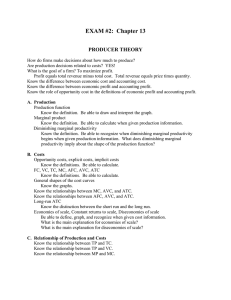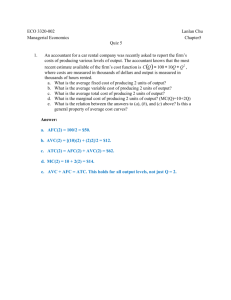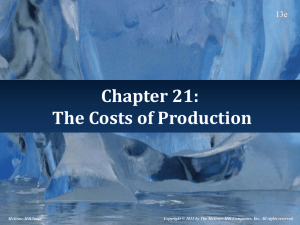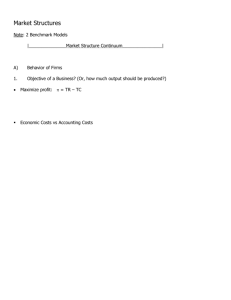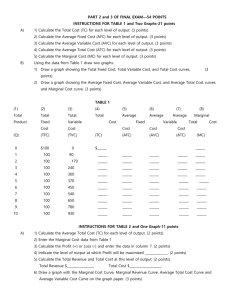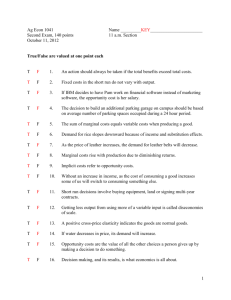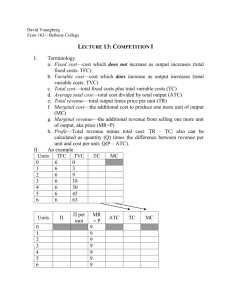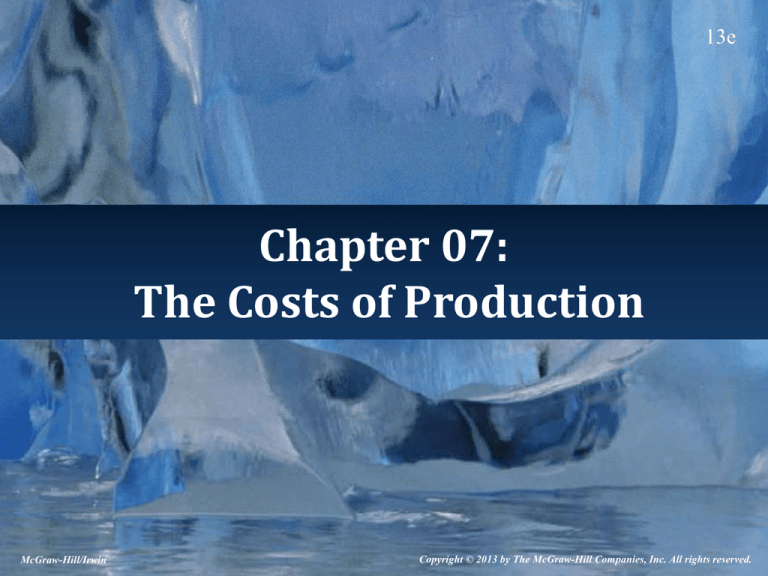
13e
Chapter 07:
The Costs of Production
McGraw-Hill/Irwin
Copyright © 2013 by The McGraw-Hill Companies, Inc. All rights reserved.
The Costs of Production
• Before anyone can consume to satisfy wants
and needs, goods and services must be
produced.
• Producers are profit-seeking, so they aim to
produce a salable product at the lowest cost
of resources used.
– Many times this means producing overseas.
7-2
The Costs of Production
• However, costs are not the only consideration.
Productivity is also important.
– Paying $10 an hour to typist A who types 90 words
a minute is a lot cheaper than paying $2 an hour to
typist B who types 10 words a minute.
• Exercise: Compare the cost of words per hour
in the example above.
– A: 5,400 words/$10 = 540 words/$1
– B: 600 words/$2 = 300 words/$1
7-3
Learning Objectives
• 07-01. Know what the production function
represents.
• 07-02. Know how the law of diminishing
returns applies to the production process.
• 07-03. Describe how the various measures of
cost are related.
• 07-04. Discuss how economic and accounting
costs are different.
• 07-05. Understand (dis)economies of scale.
7-4
The Production Function
• Production function: a technological
relation-ship expressing the maximum
quantity of a good attainable from different
combinations of factor inputs.
– In other words, how much can we produce with
the land, labor, and capital available?
– We will consider the land to be a fixed amount.
So we can vary only the labor and the capital.
7-5
The Production Function
• In order for labor to produce, it needs land
and capital. With neither, production is zero.
• With fixed land and capital, adding more
labor will increase production.
– First, at a rapid rate as the added workers put
the capital to full use.
– Later, more workers will not add as much new
production as workers overwhelm the available
capital.
7-6
The Production Function
• The productivity
of any factor of
production (e.g.,
labor) depends on
the amount of
other resources
(e.g., capital)
available to it.
7-7
The Production Function
• Note that when capital is fixed, as labor
increases, output increases but ultimately at
a slower rate. Ultimately output maxes out
and begins to decline.
– The measure of this added output as labor
increases is marginal physical product (MPP).
7-8
Marginal Physical Product (MPP)
7-9
Diminishing Marginal Returns
• Law of diminishing returns: the marginal
physical product of a variable input declines
as more of it is employed with a given
quantity of other (fixed) inputs.
– Added output begins to decrease and ultimately
goes negative as more and more workers are
added with no increase in capital.
7-10
Resource Costs
• The sales manager wants to maximize sales
revenue.
• The production manager wants to minimize
production costs.
• The business owner wants, instead, to
maximize profit.
• There is no reason to expect these three
goals to occur at the same output.
7-11
Resource Costs
7-12
Resource Costs
• As MPP decreases with added workers, we
continue to pay the added workers, but we get
less added product with each added worker.
• Therefore, the cost per added product
increases as MPP declines.
• Marginal cost (MC): the increase in total cost
associated with a one-unit increase in
production.
7-13
Marginal Cost (MC)
Change in total cost
Marginal cost (MC) =
Change in output
• When MPP decreases, MC must increase,
and vice versa.
• For any production with fixed capital, the
MC curve will fall at low levels of production
but will rise sharply at higher levels when
diminishing marginal returns set in.
7-14
Dollar Costs
• Total cost (TC): the market value of all
resources used to produce a good or service.
• Fixed cost (FC): costs of production that
don’t change when the rate of output is
altered.
• Variable cost (VC): costs of production that
change when the rate of output is altered.
Total Costs = Fixed costs + Variable costs
TC
=
FC
+
VC
7-15
Fixed Costs
• Payments for the fixed inputs.
• Includes the cost of basic plants and
equipment.
• Must be paid even if output is zero.
• Do not increase as output increases.
7-16
Variable Costs
•
•
•
•
Payments for the variable inputs.
Include the costs of labor and raw materials.
At zero output, these costs are zero.
As output increases, variable costs increase
rapidly at first, then more slowly, and finally
very fast as the firm approaches maximum
capacity.
7-17
Average Costs
• Average total cost (ATC): total cost divided by the
quantity of output in a given time period.
– ATC = TC / q
• Average fixed costs (AFC): total fixed cost divided by
the quantity of output in a given time period.
– AFC = FC / q
• Average variable cost (AVC): total variable cost
divided by the quantity of output in a given time
period.
– AVC = VC / q
7-18
Characteristics of the Cost Curves
• Falling AFC: as output increases, AFC decreases
rapidly. Any increase in output will lower AFC.
• U-shaped AVC: AVC decreases at first, hits a
minimum, and then rises as output increases
(as a result of diminishing returns).
• U-shaped ATC: at low output, falling AFC
dominates and ATC decreases. As output
increases, rising AVC begins to dominate. ATC
hits a minimum, then begins to rise.
7-19
Minimum Average Cost
• The output at which ATC switches from being
dominated by AFC to being dominated by
rising AVC is the point where average costs are
minimal.
– It is at this output where the firm can produce at
the lowest cost per unit...
– … and where the firm minimizes the amount of
resources being used.
– However, this amount of output is not necessarily
the output where profit is maximized.
7-20
Marginal Cost (MC)
Change in total cost
Marginal cost (MC) =
Change in output
• Diminishing returns in production cause MC to
increase as output increases.
• After a brief drop in MC at low output, MC rises
rapidly as output increases.
• As MC rises, it intersects ATC at its minimum
point.
• ATC decreases when MC<ATC.
• ATC increases when MC>ATC.
7-21
Economic vs. Accounting Costs
• Accountants count only dollar costs of
production – that is, the explicit costs.
– Explicit costs: a payment made for the use of a
resource.
• Economists add the value of all other resources
used in production, including resources not
paid for in dollars.
– Implicit costs: the value of resources used in
production, even when no direct payment is made.
7-22
Economic vs. Accounting Costs
Economic cost = Explicit costs + Implicit costs
• Explicit costs can be identified by the
accountant with a paper trail denominated in
dollars.
• Implicit costs are the cost of resources for
which no payment is made – that is, the
opportunity cost of using those resources. They
can be identified only by the entrepreneur.
7-23
Long-Run Costs
• The short run is characterized by fixed costs.
– In the short run, the plants and equipment are
fixed.
– The objective is to make the best use of those fixed
inputs while making the production decision.
• In the long run, we can change the plants and
equipment.
– Long run: a period of time long enough for all
inputs to be varied.
– There are no fixed costs in the long run. All costs
are variable.
7-24
Long-Run Average Costs
• In the long run, a firm
can build a plant of any
desired size.
• As plant size gets
larger, each plant’s ATC
curve has a lower
minimum point.
• In this case, building a
larger plant would
lower production
costs.
7-25
Long-Run Average Costs
• There are unlimited
options.
• One option delivers
the lowest ATC.
• It is at this point
where the long-run
marginal cost curve
intersects the longrun average total
cost curve.
7-26
Economies of Scale
• Economies of scale: reductions in minimum
average costs that come through increases
in the size (scale) of plants and equipment.
– Larger plants reduce minimum average costs.
– Greater efficiency may come from
• Specialization vs. multifunction workers.
• Mass production vs. small batch mode production.
7-27
Diseconomies of Scale
• If the plant size gets too big, however, longrun average costs begin to rise, creating
diseconomies of scale.
– Operating efficiency may be reduced.
– Worker alienation may increase.
– Rigid corporate structures emerge.
– Off-site management may be unresponsive.
• Bigger isn’t always better.
7-28

